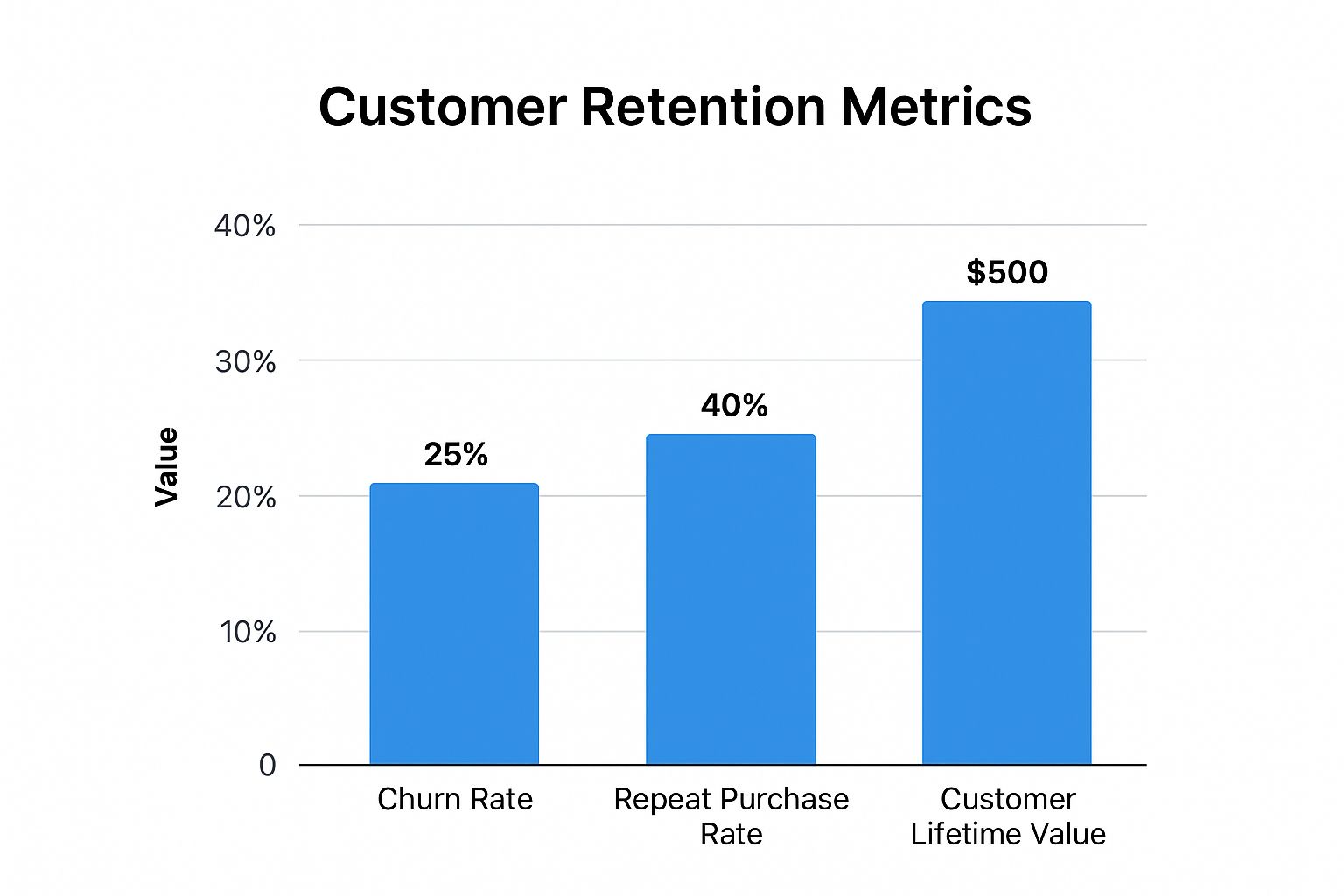Customer retention isn’t just some corporate buzzword—it’s the real work of keeping your existing customers happy, engaged, and coming back for more. Think of it as the art and science of building lasting relationships, ensuring that the people who’ve already chosen you once will continue to choose you over and over again.
It’s about turning that first sale into a long-term partnership.
Defining Customer Retention In The Real World

Imagine your customer base is a garden. You could spend all your time and resources trying to plant new seeds (that’s customer acquisition). Or, you could focus on nurturing the plants you already have, helping them grow strong and produce a reliable harvest year after year. That’s customer retention.
While you absolutely need both, tending to your existing garden is often where the most sustainable, profitable growth comes from.
So, what is customer retention at its core? It’s every single thing your business does to keep its current customers in the fold. It's about creating a consistently positive experience that builds trust and loyalty, not just at the point of sale, but throughout their entire journey with you.
Getting A Read On Your Retention
To see how you're doing, you need to track your Customer Retention Rate (CRR). This simple metric tells you what percentage of your customers stuck around over a certain period. The formula is pretty straightforward:
This calculation gives you a quick, clear snapshot of how well you're holding onto the customers you worked so hard to win in the first place.
It's A Mindset, Not Just A Metric
But retention is so much more than a number on a dashboard; it’s a whole business philosophy. It’s the understanding that the real value isn’t just in that first transaction, but in the lifetime of that relationship. When you get this right, the benefits are huge.
- Boosted Profitability: It costs far less to keep a customer you already have than it does to go out and find a new one. The math just works.
- Higher Customer Lifetime Value (CLV): Loyal customers don’t just stick around; they tend to spend more over time as their trust in you grows.
- Powerful Word-of-Mouth Marketing: Nothing beats a happy customer telling their friends about you. They become your best, most authentic salespeople.
For example, customer retention is a crucial metric for businesses in every region. By focusing on it, you’re not just chasing transactions—you’re building a stable foundation for real, long-term success. If you want to dive deeper, you can find great strategies to improve client retention for lasting growth that can make a tangible difference.
The Compounding Value of Customer Loyalty

It’s one thing to know what customer retention is, but it’s another thing entirely to grasp its true financial power. Don’t think of your loyal customer base as just a list of people who buy from you. Instead, picture it as a high-yield savings account. Every positive interaction you have with them is a deposit, and over time, that value doesn't just add up—it compounds.
This compounding effect is real because the math behind a long-term customer relationship is completely different from a one-and-done sale. The longer a customer sticks around, the more profitable they become.
The Economics of Loyalty
The financial upside of customer loyalty isn't just a vague concept; it's something you can actually measure. As customers get comfortable with your services and learn to trust your brand, their value naturally climbs while the cost to keep them happy often goes down.
Here’s a look under the hood of this financial engine:
- Reduced Service Costs: Veteran customers already know the ropes. They understand your processes and need far less hand-holding, which means fewer support calls and smoother, quicker interactions for everyone.
- Increased Spending: Trust is the ultimate revenue driver. A loyal customer is way more likely to give your new services a shot, upgrade their plan, or simply order more often. All of this drives their lifetime value through the roof.
- Lower Price Sensitivity: When a customer genuinely values their relationship with your business, they're not going to jump ship over a competitor's slightly lower price. They stay for the quality and reliability they know they can count on from you.
This all creates a powerful cycle of profitability that feeds itself. Even a tiny bump in retention can have an outsized impact on your bottom line. For instance, research consistently shows that a mere 5% increase in customer retention can boost profits anywhere from 25% to 95%. This is exactly why focusing on loyalty isn’t just good practice—it’s one of the smartest growth strategies out there. You can read the full research on customer retention statistics to dive deeper into the numbers.
Your Best Sales Force Is Already on Payroll
Beyond the direct cash flow, the real magic of customer loyalty is word-of-mouth marketing. Your happiest, most dedicated customers will become your most passionate—and affordable—sales team.
These brand advocates organically generate warm, high-quality leads for your field sales team at almost no cost. Their authentic stories cut through the marketing noise, making your job of finding new customers that much easier. Investing in keeping them happy isn't an expense; it's a direct investment in your company's future.
Measuring What Matters for Customer Retention
Knowing what customer retention is is one thing. Actually improving it? That’s a whole different ball game. You can't strengthen what you don't measure, and trying to boost retention without tracking the right data is like driving with a blindfold on.
By keeping an eye on the right metrics, you turn retention from a vague business goal into a sharp, data-driven strategy. It’s how you pinpoint what’s working, what’s falling flat, and where to focus your energy next. Think of these metrics as the vital signs for your customer relationships—they tell you exactly how healthy your customer base is.
The Core Metrics You Need To Track
To really get a handle on retention, you don’t need a hundred different data points. You just need a few essential ones. Each tells a different part of the story, and together they give you a clear picture of how loyal your customers are and what that means for your bottom line.
Here’s a quick rundown of the key metrics to keep on your dashboard.
table block not supported
These metrics work together to show you the bigger picture.
Turning Data Into Action
This bar chart shows how these metrics can paint a very real picture of a business's health.

You can see that even with a decent repeat purchase rate and CLV, a 25% churn rate means you’re constantly trying to fill a leaky bucket. That’s a lot of customers walking out the door.
These numbers are direct feedback from your market. A tanking NPS score might mean it’s time to have a serious look at your customer support processes. A low CLV could indicate that your team isn't finding opportunities to upsell or cross-sell to happy customers. This is also where things get really interesting when you compare it to your acquisition costs. For a deeper dive, check out our guide on calculating customer acquisition cost and see how it stacks up against your CLV.
If you’re ready to go beyond the basics, exploring more advanced key user retention metrics can give you even sharper insights to fuel your growth.
Actionable Strategies to Boost Customer Loyalty
Knowing your numbers is one thing, but turning that data into real-world results is where the magic happens. The good news? Building customer loyalty doesn’t demand huge, flashy gestures. It’s all about the small, consistent, and thoughtful actions that show your customers you’re paying attention.
To turn happy customers into die-hard fans, you need to be proactive. You can't just cross your fingers and hope they return; you have to give them a reason to. This means shifting your mindset from simply reacting to problems to actively building the relationship long after the deal is done.
Build a Proactive Communication Calendar
One of the most effective ways to keep customers engaged is through consistent, valuable communication. Don't just pop up when you have something new to sell. A solid communication plan keeps your brand at the forefront of their minds and proves you're there to help, not just to profit.
Your calendar could be as simple as this:
- Onboarding Follow-Ups: A quick check-in a week after a purchase to see if they need help or have questions.
- Educational Content: Monthly emails with tips or best practices that help them get more out of what they bought from you.
- Simple Check-Ins: A short, personal note every quarter just to ask how things are going can go a surprisingly long way.
This kind of steady contact makes a real difference. In fact, 60% of consumers say great customer service is a major factor in their loyalty, and positive experiences can convince them to spend up to 140% more.
Design a Loyalty Program with Real Benefits
A great loyalty program is more than just a glorified discount card. It should create a sense of community and exclusivity, making your best customers feel like they're part of an inner circle. The trick is to offer rewards they genuinely care about, moving beyond the basic "spend more, save more" model.
Think about perks that actually have an impact:
- Early Access: Let your loyal customers get their hands on new products or features before anyone else.
- Exclusive Content: Give them access to special webinars, in-depth guides, or one-on-one time with experts.
- Tiered Rewards: Set up levels like Bronze, Silver, and Gold that unlock better perks as they go. It adds a bit of fun to the experience and encourages them to stick around.
Create a Seamless Feedback Loop
At the end of the day, the easiest way to know what your customers want is to simply ask them. Make it incredibly easy for them to share their thoughts—and then, crucially, show them you're listening. This closes the loop and proves their opinion is valued.
Implementing effective strategies to reduce churn rate is fundamental for building this kind of long-term trust. You don't need a massive, complicated system. A short survey or even a direct question during a check-in call can give you the priceless insights you need to keep them happy.
How a CRM Powers Your Retention Strategy

A great retention plan is more than just good intentions—it needs a central hub to make it happen. Think of a Customer Relationship Management (CRM) system as the brain of your entire retention operation. It’s what turns your big-picture strategy into the small, consistent actions your team takes every single day.
Could you remember every last detail from every single customer conversation off the top of your head? Of course not. It's impossible. A CRM like LeadFlow Manager acts as your team’s shared memory, making sure every touchpoint is logged and easy to find, from the first hello to the most recent support ticket.
This completely transforms the customer experience. Clients no longer have to re-explain their situation to three different people. Instead, anyone on your team can jump in with full context, delivering that seamless, personal touch that makes customers feel genuinely valued. This is what customer retention truly looks like in action.
Centralize Every Customer Interaction
Few things kill customer loyalty faster than a scattered, disorganized history. When client details are squirreled away in different spreadsheets, personal notebooks, or a mess of disconnected apps, crucial information inevitably falls through the cracks. This forces your customers to repeat themselves, which is not only frustrating for them but also makes your business look disorganized.
A CRM fixes this by creating one single source of truth. Every email, call, and note lives in one place. This unified view lets your team get ahead of issues instead of just reacting to them. For growing companies, learning how a CRM can support small business growth is often the first real step toward building a retention process that can actually scale.
Automate Your Follow-Ups
Consistent follow-up is the bedrock of any strong relationship, but let’s be honest—when your team is swamped, it’s easy for things to slip. A CRM’s automation features are your safety net, ensuring no opportunity to connect is ever missed.
You can set up automated triggers for all the key moments in a customer's journey:
- Post-Sale Check-ins: Automatically schedule a follow-up call 30 days after a deal closes.
- Renewal Reminders: Ping your reps when a client's contract is coming up for renewal.
- Feedback Requests: Send out a quick survey right after a service call to capture immediate feedback.
Building a Culture That Lives and Breathes Retention
Tools and tactics are great, but they’re only one piece of the puzzle. The most powerful customer retention strategy isn't a playbook; it's woven directly into the DNA of your company.
A business that truly gets retention doesn't just do customer-centric things—it is customer-centric, from the top leadership down to the newest hire. It’s a place where every single team member feels a genuine sense of ownership over the customer experience. This is where you shift the entire company’s focus from just closing the next deal to guaranteeing long-term customer success.
When that happens, retention stops being a line item on a departmental report. It becomes the shared mission that guides every single decision.
Fostering a Customer-Centric Mindset
The bedrock of a retention-first culture is empathy. It all starts with training your teams not just on what your product does, but on how to truly listen and understand a customer's world and their challenges. This goes way beyond simply solving the problem in front of them; it’s about anticipating their needs before they even have to ask.
To make this real, leaders have to walk the walk. That means setting up performance goals that reward more than just raw sales numbers.
- Reward Retention Wins: When a team member goes the extra mile to save a client or gets glowing feedback, celebrate it publicly. Make heroes out of the people who champion your customers.
- Incorporate Customer Feedback: Customer satisfaction scores shouldn't just be for the support team. Make them a key part of performance reviews for everyone.
- Empower Your Team: Give your people the autonomy to make decisions that benefit the customer without getting tangled up in red tape. Trust them to do the right thing.
This completely changes what motivates your team. For a deeper dive, our guide on proven strategies for motivating a sales team has some brilliant ideas you can adapt across your entire organisation.
By making empathy a priority, celebrating customer-focused actions, and empowering your employees, you build a sustainable engine for growth that no competitor can easily copy.
Your Top Customer Retention Questions, Answered
As you start focusing more on customer retention, a few common questions always seem to pop up. Let's tackle them head-on with some straight-to-the-point answers.
What Is A Good Customer Retention Rate?
This is the million-dollar question, and the honest answer is: it depends. A "good" rate can look wildly different from one industry to the next. For a SaaS company, anything below 80% might be a red flag, but for a retail store, hitting 60% could be fantastic.
